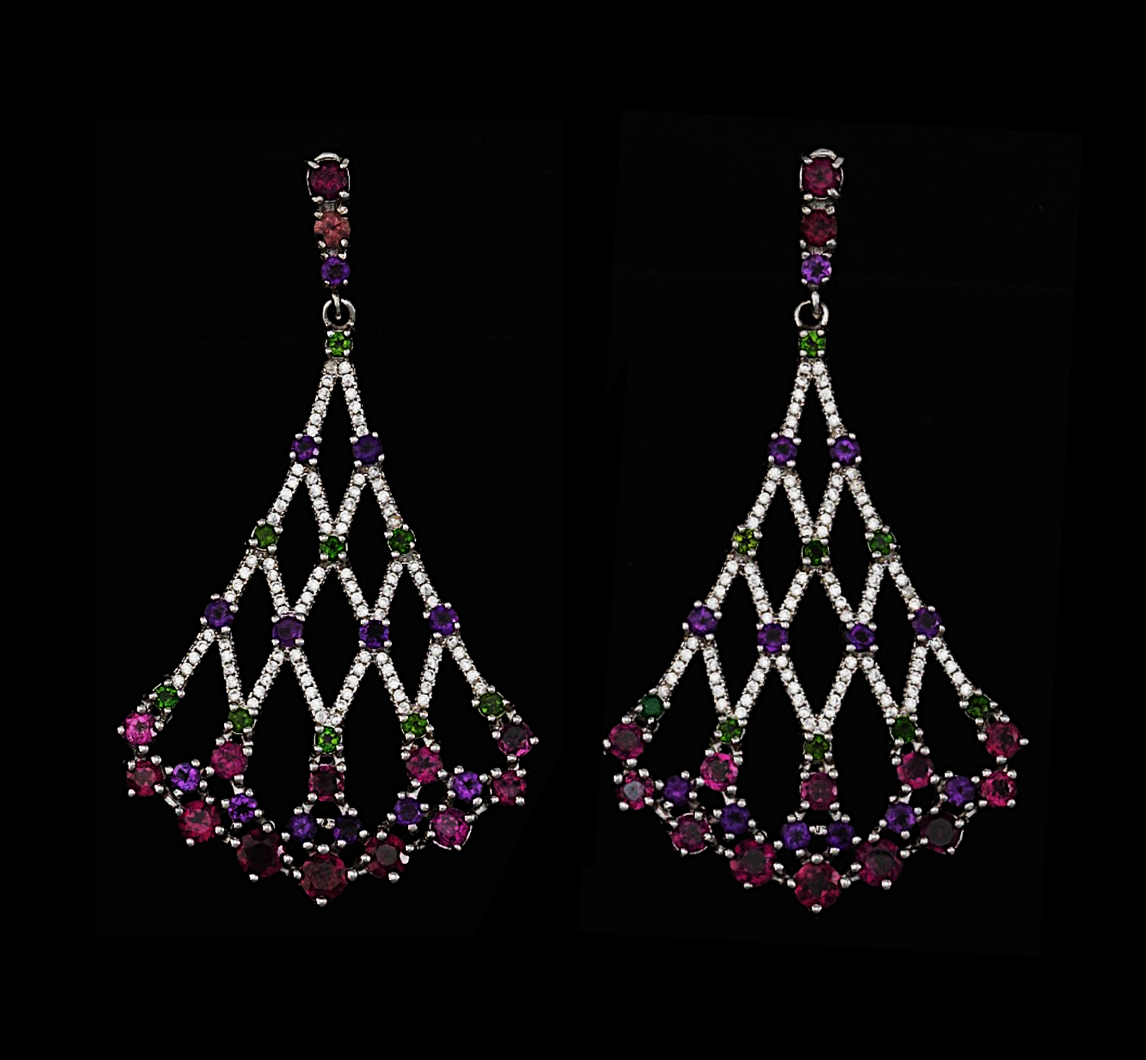

Title: Peacock Tail Silver Amethyst Pink Tourmaline Tsavorite Dangle Earrings
Shipping: $29.00
Artist: N/A
Period: 20th Century
History: Art
Origin: North America > United States
Condition: N/A
Item Date: N/A
Item ID: 210
From a private estate. Ruby and diamond style Art deco decorative collectible art jewelry. A Spectacular Pair of Ladies' Sterling Silver, Amethyst, Pink Tourmaline, Tsavorite and Clear Stone Lattice Dangle Art Deco Earrings 2 ⅜" x 1 ⅜" Sterling silver pair of dangle earrings with pierced clip-on back, fashioned and lattice style peacock tail, set with round cut amethysts, measuring 2.5mm each, tsavorites, measuring 2mm each, pink tourmalines, measuring from 3mm to 4.5mm, accented with round brilliant-cut clear stones; marked on the clasp; overall weight 18.5 gm. Condition: Very good, natural inclusions in stones. Art Deco is a style that emerged in 1925, a result of exhibits at the World's Fair held in Paris, France. The term Art Deco is a shortened form of the event's name: Exposition Internationale des Arts Décoratifs et Industriels Modernes (International Exposition of Modern Industrial and Decorative Arts).
Certain design elements are consistent throughout period pieces, making it easy to identify cars, fashions, and even buildings. Authentic jewelry from this period was made between 1920 and 1935 and has at least one, sometimes all, of the following traits listed below. The jewelry styles remained popular through the late 1930s and have since reemerged as one of the most popular antique jewelry styles. Art Deco jewelry precedes the Edwardian Era. For jewelry novices, it can be difficult to tell the difference between the two eras since both incorporate platinum and antique diamonds. However, Art Deco design differs from Edwardian design in that it is more geometric and symmetrical. Where the Edwardian turn of the century jewelry was very nature-inspired, light, and flowy, Art Deco design incorporates more geometric shapes, less free space, and a more industrial feel.
Link: https://en.wikipedia.org/wiki/Art_jewelry
Art jewelry is one of the names given to jewelry created by studio craftspeople. As the name suggests, art jewelry emphasizes creative expression and design and is characterized by the use of a variety of materials, often commonplace or of low economic value. In this sense, it forms a counterbalance to the use of "precious materials" (such as gold, silver, and gemstones) in conventional or fine jewelry, where the value of the object is tied to the value of the materials from which it is made. Art jewelry is related to studio craft in other media such as glass, wood, plastics, and clay; it shares beliefs and values, education and training, circumstances of production, and networks of distribution and publicity with the wider field of studio craft. Art jewelry also has links to fine art and design.
While the history of art jewelry usually begins with modernist jewelry in the United States in the 1940s, followed by the artistic experiments of German goldsmiths in the 1950s, a number of the values and beliefs that inform art jewelry can be found in the arts and crafts movement of the late nineteenth century. Many regions, such as North America, Europe, Australasia, and parts of Asia have flourishing art jewelry scenes, while other places such as South America and Africa have been developing the infrastructure of teaching institutions, dealer galleries, writers, collectors and museums that sustain art jewelry.
Curator Kelly L'Ecuyer has defined studio jewelry as an offshoot of the studio craft movement, adding that it does not refer to particular artistic styles but rather to the circumstances in which the object is produced. According to her definition, "Studio jewelers are independent artists who handle their chosen materials directly to make one–of–a–kind or limited production jewelry..... The studio jeweler is both the designer and fabricator of each piece (although assistants or apprentices may help with technical tasks), and the work is created in a small, private studio, not a factory." Art historian Monica Gaspar has explored the temporal meaning of the different names given to art jewelry over the past 40 years. She suggests that "avant–garde" jewelry positions itself as radically ahead of mainstream ideas; "modern" or "modernist" jewelry claims to reflect the spirit of the times in which it was made; "studio" jewelry emphasizes the artist studio over the craft workshop; "new" jewelry assumes an ironic stance towards the past, and "contemporary" jewelry claims the present and the "here and now" in contrast with traditional jewelry's eternal nature as an heirloom passing between generations.
The art historian Maribel Koniger argues that the names given to art jewelry are important in order to distinguish this type of jewelry from related objects and practices. The use of the term "conceptual" jewelry is, in her words, an "attempt to detach oneself through terminology from the products of the commercial jewelry industry that reproduce cliches and are oriented towards the tastes of mass consumption on the one hand, and, on the other, the individualistic, subjectively aestheticising designs of pure craft.